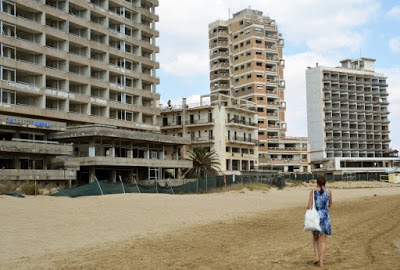An interactive platform is working to change the future of the city
A passionate team of architects, designers and town planners from both communities, full of hope and perseverance, are working to change the future of Famagusta
At a time when the Turks, with their provocation and intransigence, are torpedoing every effort for a solution of the Cyprus problem, with the most recent example of their attitude being the withdrawal from the talks on the decision of the Parliament for the union referendum, a passionate group of architects , designers and urban planners from both communities, full of hope and perseverance, are working to change the future of Famagusta.
Hands up
The bi-communal initiative "Hands on Famagusta", led by Socrates Stratis, Associate Professor at the Department of Architecture of the University of Cyprus, has developed over the last five years ways in which civil society can participate in shaping common visions for the city. Famagusta, after the reunification of the island, forming relations of reconciliation and urban reconstruction of the city. For this purpose, they have set up a trilingual interactive platform, the "Hands on Famagusta", as well as a mobile model of the entire city of Famagusta, after a detailed on-site survey of the city areas, except the enclosed area.
The initiative is already five years old, since the idea of the project started five years ago. Since 2012, workshops, lectures, discussions on TV shows have been organized, forming new questions and common concerns for the citizens of Cyprus, on both sides of the dividing line. And the question is one. What ways should one look for, in order to avoid the planning of the next divided city of Cyprus from Deryneia to the ancient Salamis?
Smart file
The interactive online platform acts as a "smart archive" that supports the shaping of the city's public. Encourages civil society to take a stand on the future of the city, having previously been informed about both the city's integration issues (broad public coastal front, common infrastructure, common eco-culture) and the controversies that may arise in its process reconstruction. A collective structure has been formed, thanks to the translation practice in three languages, adopted by study groups for the easier understanding of the "smart archive" by all members of Cypriot society. The archive contains new questions about the challenges of the reconstruction process, but also data on the number of buildings, their height, the length of roads, the extent of ecological areas.
Both the interactive platform and the mobile model have supported many activities in the last year, both in Cyprus and abroad.
An activity took place on the pedestrian street of Ledra Street, in front of the building of the Department of Architecture, where passers-by had the opportunity to explore the model. Another took place in the church of the Apostles Peter and Paul, in old Famagusta, which was supported by both the Greek Cypriot and the Turkish Cypriot community of Famagusta. Last fall, workshops were held, where participants had the opportunity to get in touch with both the work of the initiative "Hands on Famagusta" and the works of students of the School of Architecture of the University of Cyprus.
In fact, recently the team behind "Hands on Famagusta" sent a letter to both the President of the Republic and the representatives of the Turkish Cypriot community, informing them that they are at the disposal of the formation of a joint institution, which will allow the planning of Famagusta in its whole. The same letter mentions the dangers lurking in the planning of the next divided city of Cyprus, since both the Turkish Cypriot municipality of Famagusta and the Reconstruction and Resettlement Council, which acts as the technical service of the Greek Cypriot Municipality of Famagusta, have recently of the city, without the possibility of communication due to unresolved political problems.
In the crosshairs of Turkey
The city of Famagusta before the Turkish invasion had about 40.000 inhabitants and was the third largest city on the island. Until the barren day of August 14, 1974, the port of Famagusta was the main port of Cyprus and tourism, the sector in which the city stood out. It is indicative that out of the approximately 100 hotels that operated throughout the island, 45 were in Famagusta.
The tourist and in general the rapid economic development of the city resulted in Famagusta becoming the most important city in terms of cultural development, since it was the main cultural pole of the island, with most festivals and events.
Famagusta was targeted by the Turks during the second phase of the invasion. The first phase took place on July 20, 1974, when more than 40.000 Turkish soldiers, supported by the Turkish Air Force and Navy, invaded the northern coast of the Republic of Cyprus.
The landing of the Turkish troops was completed almost a month later, on August 14, 1974, with the invasion of Famagusta. In just two days, the Turks occupied most of the Mesaoria plain, Famagusta, Karpasia and most of the Morphou area.
The Turkish invasion resulted in more than 4.000 dead and 1.619 missing, while more than 200.000 residents were expelled from their homes and became refugees within their own homeland. The Turks occupied 65% of the arable land, 70% of the mineral wealth, 70% of the industry, 80% of the tourist facilities.
Famagusta, after its occupation by the Turkish troops, was looted, sealed and until today the access is forbidden.
The Swedish journalist Jan-Olof Bengston, who visited the port of Famagusta and described the sealed city as "ghost town", wrote: "The paved road was filled with cracks and bushes grew on the sidewalks. Today -September 1977-, the tables where breakfast is served are there, the laundry spread on the ropes and the light bulbs on. Varosi is a ghost town ".
Source: SigmaLive

